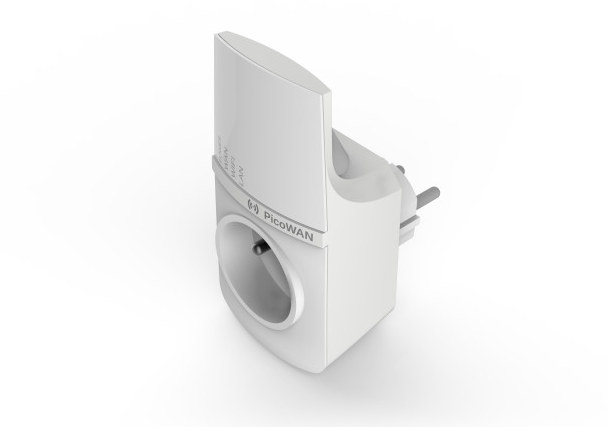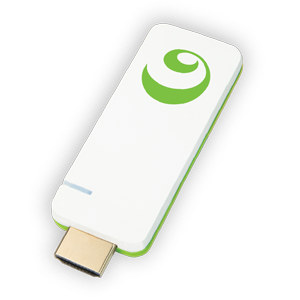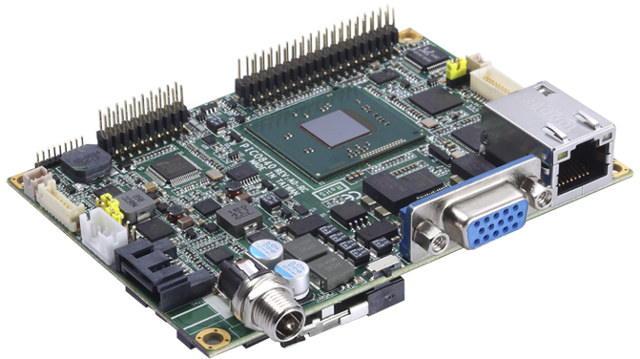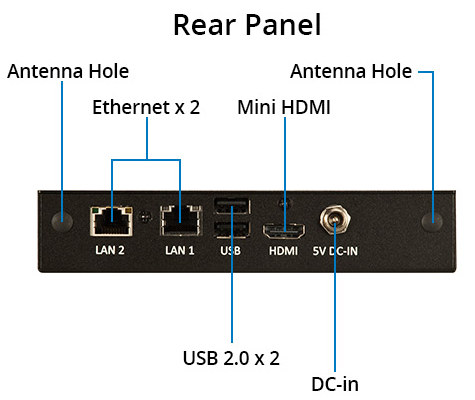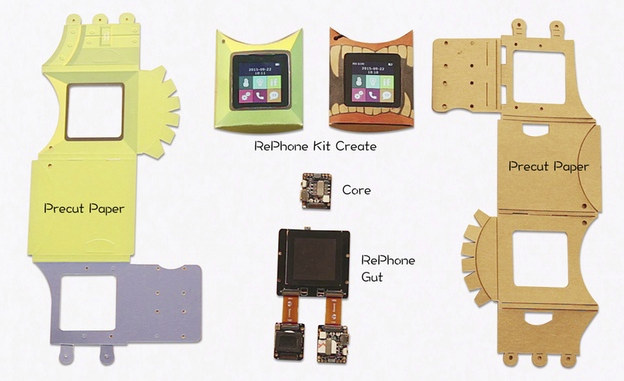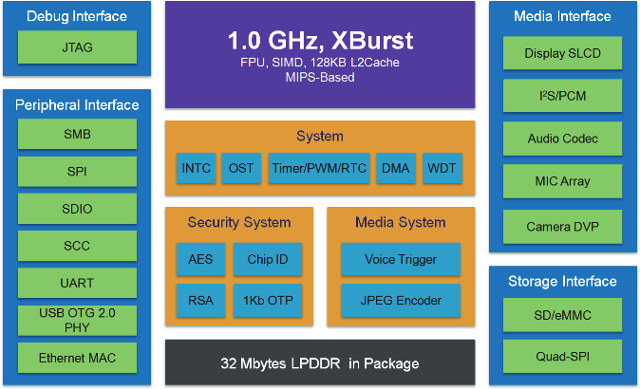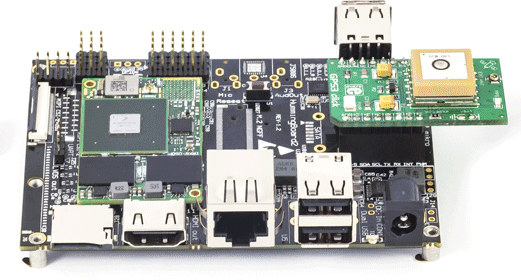The Internet of Things is promising billions of connected devices in the next few years, and while devices at home can usually connect through your broadband connection at no extra cost, devices on the field may need to use cellular connectivity and cheap 2G network are being phased out by Telcos. Weightless, operating over white space frequencies, is one of several solutions proposed to connect IoT objects over longer distances, but Archos has their own project with PicoWAN pico-gateways using LoRa(WAN) protocol which allows for several kilometers range. PicoWAN would plug into your wall socket, connect to your broadband network over WiFI and offer connectivity to various “things” over LoRa. Creating a cellular network is expensive, due to the costs of base stations, but PicoWAN is so cheap, 100 times cheap than traditional base stations, that Archos plans to giveaway 200,000 gateways across Europe to create an IoT network. That […]
Kinoma HD is $25 TV Stick Devkit Based on Marvell ARMADA 1500 Mini Plus Processor
Marvell has just revealed that ChromeCast 2.0 & Audio featured their ARMADA 1500 Mini Plus (88DE3006) processor with two ARM Cortex A7 cores, coupled with 512 MB RAM, and Avastar 88W8887 wireless solution with WiFi 802.11 b/g/n/ac, Bluetooth 4.1, NFC and FM radio. But a comment on Anandtech lead me to a development kit based on 88DE3006 I missed while I was away: Kinoma HD. Preliminary hardware specifications: SoC – Marvell ARMADA 1500 Mini Plus (88DE3006) dual core Cortex A7 @ 1.2 GHz with 3D GPU supporting OpenGL ES 1.1/2.0, Qdeo video engine System Memory – 256 MB RAM Storage – TBD Video Output – HDMI output of 1080p/720p Connectivity – Wi-Fi g/n/ac Power Supply – 5V via micro USB port Apart for the lower memory capacity (256MB vs 512MB), Kinoma HD hardware looks pretty similar to ChromeCast 2.0. But the main difference is in the software, as while ChromeCast […]
Axiomtek PICO842 Fanless Bay Trail Pico-ITX Motherboard Includes a SO-DIMM Socket and SATA Ports
Axiomtek PICO842 is a fanless Pico-ITX motherboard that features Intel Celeron J1900 quad core processor or Celeron N2807 dual core processor with up to 8GB DDR3L, and aimed at IoT & medical applications, automation, and embedded systems with wide temperature range requirements. Axiomtek PICO842 specifications: SoC Intel Celeron J1900 quad core processor up to 2.42 GHz OR Intel Celeron N2807 dual core processor up to 2.16 GHz System Memory – 1x DDR3L-1066/1333 SO-DIMM up to 8GB for J1900, and 4GB for N2807 Storage – 1x SATA-300, 1x mSATA Video Output – 1x 18/24-bit single/dual channel LVDS, and 1x HDMI or 1x VGA Audio – HD Codec audio (Realtek ALC662); MIC-in/Line-out Connectivity – Gigabit Ethernet (Intel i211AT) USB – 4x USB 2.0 host port Serial – 2x COM ports supporting RS-232, RS-422, and RS-485. Expansion – mini PCI Express (shared with mSATA support) Power Supply – 12V DC power jack. Battery […]
VIA Artigo A820 Enterprise IoT Gateway Is Powered by Freescale i.MX 6DualLite Processor
VIa has just launched a new fanless IoT gateway targeting the enterprise market. Artigo A820 features Freescale i.MX 6DualLite Cortex A9 processor with dual Ethernet ports as well as DIO and serial ports, and optional wireless networking modules adding WiFi, 3G, and GPS connectivity. Artigo A820 specifications: SoC – Freescale i.MX 6DualLite dual core ARM Cortex-A9 @ 1.0 GHz with Vivante GC880 GPU System Memory – 1GB DDR3 SDRAM Storage – 4GB eMMC Flash + internal micro SD card Connectivity 1x Gigabit Ethernet (Micrel KSZ9031RNX with RGMII support) 1x 10/100M Ethernet (using ASIX AX88772 USB 2.0 to 10/100Mbps Fast Ethernet Controller), Optional VNT9271BU0DB IEEE 802.11 b/g/n USB Wi-Fi dongle Optional Ublox 3.75G HSPA/UMTS Mobile mini PCIe module with GPS and SIM card slot 2 Antenna holes for 3G or Wi-Fi Video Output – mini HDMI 1.4 USB – 3x USB 2.0 host ports Serial – 1x COM port for RS232/485; […]
ARM TechCon 2015 Schedule – IoT, Servers, 64-bit ARM, Power Usage Optimization, and More
The ARM Technology Conference (ARM TechCon) will take place on November 10 – 12, 2015, in Santa Clara Convention Center, and just like every year, there will be a free exposition for companies to showcase their latest innovation and/or products, as well as a technical conference with sessions and workshops sorted into various tracks: Automotive/Embedded Vision Embedded IoT Mobile/Connectivity Networking Infrastructure/Servers Tools & Implementation Wearables/Sensors ARM Training Day Sponsored Vendor Training Special Event General Event Software Developers Workshop You can find the complete schedule on ARM TechCon website. Although I won’t attend, I’ve created my own virtual schedule with some of the sessions I found interesting. Tuesday – November 10 8:30 – 9:20 – ARM Vision for Thermal Management and Energy Aware Scheduling on Linux by Ian Rickards (ARM), Charles Garcia-Tobin (ARM), Bobby Batacharia (ARM) This talk will cover the history and where are we going, for ARM’s Power Software (IPA, […]
RePhone Kit Create is a DIY Phone and Cellular Development Kit (Crowdfunding)
Seeed Studio has design a modular and open source phone it calls RePhone Kit Create. The kit allows you, or/and your kid(s), to assemble their own phone based on building blocks including a 2G or 3G core module, a touchscreen display module, an audio module, and pre-cut, seawable, washable, and easily drawable Kraft paper to make the case. The kit can also be used for IoT applications using cellular and Bluetooth connectivity, and extra Xadow modules GPS, NFC, motion sensors, camera and more.. Two cellular “core” module can be used: RePhone GSM + BLE module with the “world’s smallest System-on-Chip (SOC) for Wearables and Internet Of Things”, GSM, GPRS and Bluetooth 2.1 and 4.0 support. RePhone Core Module 3G with a “powerful microcontroller”,a standard Xadow interface (USB, GPIO, I2C, SPI, UART, EINT), support for speaker, two microphones and a headset, a Nano SIM, and support for HSPA/WCDMA:850/1900 and GPRS/EDGE:850/1900. Voltage: […]
Ingenic X1000 MIPS Processor and X1000 Phoenix Board Target IoT and Embedded Applications
Ingenic is a Chinese SoC vendor that makes processors featuring their X-Burst cores based on MIPS architecture. Their JZ47 series can be found in tablets and development boards such a MIPS Creator CI20, while their M series, including Ingenic M200, are dedicated to wearables & IoT applications. The company has now launched X series starting with X1000 processor which include an audio codec, a Voice Trigger Engine (VTE) and 32MB RAM in package. Ingenic X1000 features: CPU Core – Ingenic MIPS XBurst 32-bit core up to 1.0 GHz, Double precision hardware float point unit, L1 cache 16KB/16KB, and L2 cache 128KB Security Core – On-chip security ROM and RAM, hardware AES and RSA, supports security boot and user customization Memory 32MB LPDDR in package Support 16-bit DDR2, DDR3 and LPDDR up to 512MB Support Quad-SPI NOR/NAND, eMMC, SDHC Display – 8-bit, 9-bit, 16-bit parallel interface SLCD up to 640×480@60Hz, 24 […]
HummingBoard Gate Boards Add a mikroBUS Socket to Support MikroElektronika Click Boards
SolidRun already released HummingBoard-Base, HummingBoard-Pro, and HummingBoard Edge previously, but the company has now launched another version of their Freescale i.MX6 based boards with HummingBoard Gate that adds a mikroBUS socket to support over 150 add-on boards – called Click Boards – made by MikroElektronika. HummingBoard Gate specifications: SoC – Freescale i.MX6 Solo, Dual Lite, Dual, or Quad with Cortex-A9 cores @ 1 to 1.2 GHz System Memory – Up to 4GB DDR3 Storage – Micro SD slot Connectivity – Gigabit Ethernet (limited to 470Mbps), optional WiFi/Bt module Video Output – HDMI output, MIPI-DSI connector Camera – MIPI CSI-4, parallel camera USB – 4x USB 2.0 ports Expansion mPCIe slot with SIM card holder 36-pin GPIO header mikroBUS click interface Misc – Reset button, RTC with battery Power – 7-36V, 5.5mm jack Dimensions – 102 x 69 mm As usual, the board is comprised of a baseboard and a microSOM, […]


